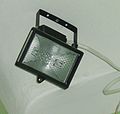Floodlight
This article has multiple issues.Please helpimprove itor discuss these issues on thetalk page.(Learn how and when to remove these template messages)
|

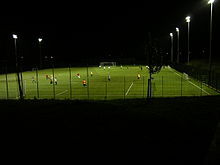
Afloodlightis a broad-beamed,high-intensityartificial light.They are often used to illuminate outdoorplaying fieldswhile an outdoor sports event isbeing held during low-light conditions.More focused kinds are often used as astage lighting instrumentin live performances such asconcertsandplays.
In the top tiers of manyprofessional sports,it is a requirement forstadiumsto have floodlights to allow games to be scheduled outside daylight hours. Evening or night matches may suit spectators who have work or other commitments earlier in the day, and enable television broadcasts during lucrativeprimetimehours. Some sports grounds which do not have permanent floodlights installed may make use of portable temporary ones instead. Many larger floodlights (see bottom picture) will have gantries for bulb changing and maintenance. These will usually be able to accommodate one or two maintenance workers.
Floodlights may also be used to add effects to buildings at night, calledarchitectural illumination.[1]

Types[edit]
The most common type of floodlight is themetal-halide lamp,which emits a bright white light (typically 75–100 lumens/Watt).Sodium-vapor lampsare also commonly used for sporting events, as they have a very highlumento watt ratio (typically 80–140 lumens/Watt), making them a cost-effective choice when certain lux levels must be provided.[2]
-
Metal halide floodlight
-
LED floodlights
-
Halogen floodlight
-
Electrodeless induction floodlight
LEDfloodlights are bright enough to be used for illumination purposes on large sport fields. The main advantages of LEDs in this application are their lower power consumption, longer life, and instant start-up (the lack of a "warm-up" period reduces game delays after power outages). They have replaced many metal halide floodlights.Halogenandelectrodeless induction floodlightsalso exist.
The first LED lit sports field in the United Kingdom was switched on atTaunton Vale Sports Clubon 6 September 2014. [3]
Sports played under floodlights[edit]
Polo[edit]
The first sport to play under floodlights waspolo,on 18 July 1878.Ranelagh Clubhosted a match inFulham,London,Englandagainstthe Hurlingham Club.[4]
Australian rules football[edit]

In August 1879, two matches ofAustralian rules footballwere staged at theMelbourne Cricket Groundunder electric lights. The first was between two "scratch" teams composed of military personnel. The following week, two of the city's leading football clubs, rivalsCarltonandMelbourne,played another night match. On both occasions, the lights failed to illuminate the whole ground, and the spectators struggled to make sense of the action in the murky conditions.
Cricket[edit]
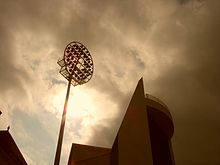
Cricketwas first played under floodlights on 11 August 1952,[5]during anexhibition gameatHighbury stadiumin England. Internationalday/night cricket,played under floodlights, began in 1979. Since then, many cricket stadiums have installed floodlights and use them for both domestic and international matches. Traditional cricket floodlights are mounted at the top of a tall pole, to elevate them out of thefielder's eyeline when the ball is hit high into the air. However, some cricket stadiums have lower-mounted floodlights, particularly if the stadium is shared with other sports.
Gaelic games[edit]
Noel Walsh's advocacy was pivotal in the spread of floodlights inGaelic games.[6]When chairman of theMunster Council,Walsh had a pilot project for floodlights atAustin Stack ParkinTraleewhich "became a template for every county and club ground in the country".[7]
Association football[edit]
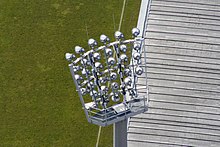

Bramall Lanewas the first stadium to host floodlit association football matches, dating as far back as 1878, when there were experimental matches at theSheffieldstadium during the dark winter afternoons. With nonational grid,lights were powered bybatteriesanddynamoes,and were unreliable.BlackburnandDarwenalso hosted floodlit matches in 1878, and in October of the same year3rd Lanark RVplayed an exhibition match againstScottish CupholdersVale of Levenatthe first Cathkin Park,with press reports suggesting the lighting from aGramme machinewas not successful in illuminating the whole field.[8]Subsequent tests over the next month using threeSiemensdynamos atthe first Hampden Park,[9]Rugby ParkinKilmarnock[10]and atPowderhall StadiuminEdinburgh[11]produced mixed results, in part due to technical issues and weather conditions.
Nottingham Forestplayed a floodlit match againstNotts Rangersat theGregory Ground,Lenton, Nottingham on 25 March 1889. This match was illuminated by 14Wells Lightswhich was a portable illumation system powered by paraffin [12]Each light had 4,000candlepower.These lights were placed around the ground and 'illuminated the playing arena well enough for the spectators to follow most, if not all, the points of play' according to the Nottingham Evening Post on 26 March 1889.[12]However the same article also reported on 26 March 1889 that 'a strong wind was blowing from the Radford goal, and this caused the lights on the town side to shed a considerable portion of their radiance on the adjoining fields, so that dark shadows were often thrown upon the playing ground and it was almost impossible to see a case of handling unless the officials were close to'.[12]The match was played at 7:45pm and Forest lost 2-0 watched by 5000 spectators.[12]
Thames Ironworks(who would later be re-formed asWest Ham United) played a number of friendly matches under artificial light at theirHermit Roadground during their inaugural season of1895–96.These experiments, which included high-profile fixtures againstArsenalandWest Bromwich Albion,were set up using engineers and equipment from theThames Ironworks and Shipbuilding Company.[13][14]
A women's football match in 1921 used floodlights, whenPreston North End's ground was covered in thick fog and the spectators couldn't see the game.[15]
In 1929 theProvidence Clamdiggersfootball club hosted theBethlehem Steel"under the rays of powerful flood lights, an innovation in soccer" at theirProvidence, Rhode Islandstadium.[16]On 10 May 1933,Sunderland A.F.C.played a friendly match in Paris againstRC Parisunder floodlights. The floodlights were fixed to overhead wires strung above and across the pitch.[17]A fresh white coloured ball was introduced after about every 20 minutes and the goalposts were painted yellow.[18]
In the 1930s,Herbert Chapmaninstalled lights into the new West Stand atHighburybut the Football League refused to sanction their use. This situation lasted until the 1950s, when the popularity of floodlit friendlies became such that the League relented. In September 1949,South Liverpool's Holly Park ground hosted the first game in England under "permanent" floodlights: a friendly against a Nigerian XI.[19]In 1950,Southampton's stadium,The Dell,became the first ground in England to have permanent floodlighting installed. The first game played under the lights there was on 31 October 1950, in a friendly againstBournemouth & Boscombe Athletic,followed a year later by the first "official" match under floodlights, aFootball Combination(reserve team) match againstTottenham Hotspuron 1 October 1951.Swindon Townbecame the first League side to install floodlights atThe County Ground.Their first match being a friendly against Bristol City on Monday 2 April 1951. Arsenal followed five months later with the first match under the Highbury lights taking place on Wednesday 19 September 1951. The first international game under floodlights of an England game atWembleywas 30 November 1955 against Spain, England winning 4–1. The first floodlitFootball Leaguematch took place atFratton Park,Portsmouthon 22 February 1956 betweenPortsmouthandNewcastle United.[20]
Many clubs have taken their floodlights down and replaced them with new ones along the roof line of the stands. This previously had not been possible as many grounds comprised open terraces and roof lines on covered stands were too low.Elland Road,Old TraffordandAnfieldwere the first major grounds to do this in the early 1990s.Deepdale,TheGalpharm Stadiumand theJJB Stadiumhave since been built with traditional floodlights on pylons.
Rugby league[edit]
The first rugby league match to be played under floodlights was on 14 December 1932 when Wigan met Leeds in an exhibition match played atWhite City Stadiumin London (8pm kick off).[21]Leeds won 18–9 in front of a crowd of over 10,000 spectators. The venture was such a success that the owners of the White City Ground took over the "Wigan Highfield" club and moved them to play Rugby League games at the ground under floodlights the following season, with most of their matches kicking off on Wednesday Nights at 8pm. That venture only lasted one season before the club moved back up north.
The first floodlit match for rugby league played in the heartlands was on 31 October 1951 atOdsal Stadium,BradfordwhenBradford NorthernplayedNew Zealandin front of 29,072.[22]
For a club to play in theSuper Leaguethey must have a ground with floodlights adequate for playing a professional game.
Winter sports[edit]
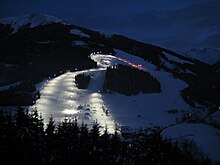
Winter sports, such as skiing and snowboarding, can be held under a floodlit piste.
Motorsports[edit]
A number of permanent motor racing circuits are floodlit to allow night races to be held. These includeYas Marina Circuit,Losail International Circuit,andBahrain International Circuit.
See also[edit]
References[edit]
- ^Architecture of the Night: A Series of Articles Published by the General Electric Company to Suggest the Possibilities of Architectural Illuminationat theInternet Archive
- ^"edisontechcenter.org".edisontechcenter.org.Archived fromthe originalon 20 September 2014.
- ^"Archived copy"(PDF).Archived(PDF)from the original on 4 March 2016.Retrieved20 November2015.
{{cite web}}:CS1 maint: archived copy as title (link) - ^Inglis, Simon(2014).Played in London.Swindon:English Heritage.p. 22.ISBN978-1-84802-057-3.
- ^"Let there be light".ESPNcricinfo.Retrieved5 May2018.
- ^Barry, Stephen (29 April 2020)."Champion of Clare football Noel Walsh has died".Irish Examiner.Retrieved29 April2020.
He was chairman of the GAA's Football Development Committee, championed the merits of the Railway Cup, and promoted the spread of floodlights to GAA grounds.
- ^O Muircheartaigh, Joe (2 May 2020)."Noel Walsh: Farewell to a driver of change and fairness".Irish Examiner.Retrieved2 May2020.
- ^Football Under the Electric Light,The Scotsman, 25 October 1878, scan via London Hearts Supporters Club
- ^Glasgow–Football Match by the Electric Light,The Scotsman, 5 November 1878, scan via London Hearts Supporters Club
- ^Football by Electric Light,The Scotsman, 9 November 1878, scan via London Hearts Supporters Club
- ^Football. | Electric Light,The Scotsman, 12 November 1878, scan via London Hearts Supporters Club
- ^abcd"Nottingham Evening Post – Football by Wells Light".Nottingham Evening Post.26 March 1889. p. 4.
- ^Powles, John (29 June 2017)."The amazing story of West Ham United's first home ground".West Ham United F.C.Retrieved12 January2018.
- ^Tongue, Steve (2016).Turf Wars: A History of London Football.Pitch Publishing. p. 23.ISBN978-1-78531-248-9.[permanent dead link]
- ^"Noticiario Futbol femenino".Mundo Deportivo(in Spanish). 17 March 1921. p. 3.
Recientemente, jugando uno de estos "matchs" en el terreno del Preston North Edd (sic), la niebla muy espesa no permitía a los espectadores seguir el juego. Entonces los "menagers" (sic) decidieron alumbrar el terreno con cuatro potentes reflectores, deslizándose el partido con todo éxito.
- ^"Draw with Providence in Night Soccer game".Bethlehem Steel Soccer.Archivedfrom the original on 11 August 2016.Retrieved23 September2016.
- ^Lanchberry, Edward (1950).Footballer's Progress: Raich Carter.Sporting Handbooks Ltd. p. 183.
- ^ Garrick, Frank (2003).Raich Carter The Biography.SportsBooks Limited. p. 34.ISBN1-899807-18-7.
- ^Jawad, Hyder; "Rest in Pieces: South Liverpool FC, 1894-1994 (2014)", p234
- ^"The History of the Football League".The Football League. Archived fromthe originalon 11 February 2007.Retrieved22 February2007.
- ^"The History of Rugby League".Rugby League Information.napit.co.uk.Archivedfrom the original on 8 December 2013.Retrieved2 January2014.
- ^"Timeline of events at Odsal stadium"(PDF).Past Times the social history of Odsal stadium project.Bradford Bulls Foundation. Archived fromthe original(PDF)on 2 April 2012.Retrieved6 September2011.



